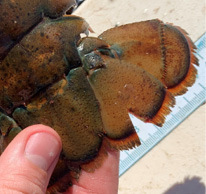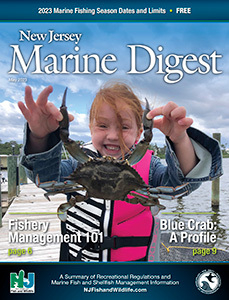Mollusks & Crustaceans
Open Season |
Minimum Length |
Harvest & Possession Limit |
Remarks |
||
Lobster, American |
|||||

|
See below for closed seasons |
3 3/8" |
6 |
A person shall not use any spear, gig, gaff or other penetrating device as a method of capture of lobsters. |
|
Blue Crab |
|||||

|
peeler or shedder |
No Closed Seasone |
3" |
1 Bushel |
Unless using non-collapsible, Cheasapeake-style crab pots, trot lines or crab dredges — see below. |
soft |
No Closed Seasone |
3 1/2" |
|||
hard |
No Closed Seasone |
4 1/2" |
|||
Hard Clam |
|||||

|
No Closed Seasonf |
1 1/2" |
150 clams |
Non-resident license valid only June–Sept. See water classification chart information at https://www.state.nj.us/dep/wms/bmw/nssphome.html |
|
Crustaceans
American Lobster
The legal possession size limit of whole lobsters, measured from the rear of the eye socket along a line parallel to the center line of the body shell to the rear of the body shell, shall be not less than
The possession limit is six lobsters per person. No person shall possess any lobster with eggs attached or from which eggs have been removed or any female lobster with a v-notched tail, as illustrated below.

Special Lobster Restrictions: No person shall use, leave, deploy, or tend any lobster, fish or conch pot within an artificial reef located in state waters except in areas designated as a full access zones. Within these designated full access zones lobster, fish and conch pots shall be used, left, deployed or tended only between sunrise and sunset.
For information about lobster pot deployment and New Jersey Reef Full Access Zone Locations, go to dep.nj.gov/wp-content/uploads/njfw/marine-letter-lobster.pdf
The use of spears, gigs, gaffs or other penetrating devices as a method of capture for lobsters is prohibited. A recreational lobster pot license is required to use pots or traps to capture lobsters. For details call
Blue Crabs

- Crabs may be taken recreationally with hand lines, manually operated collapsible traps or scoop nets without a license. A non-commercial crab pot license is required for the use of not more than two non-collapsible Chesapeake-style crab pots (see illustration) or two trot lines to harvest crabs. See
non-commercial crab pot license information. - It is illegal to harvest or possess more than one bushel of crabs per day per person or offer for sale any crabs without having in your possession a valid commercial crabbing license.
- Minimum size for crabs that may be harvested (measured from point to point of shell) are as follows:
- Peeler or shedder crab: 3 inches
- Soft crab: 3½ inches
- Hard crab: 4½ inches
- All female crabs with eggs attached and all undersized crabs shall be returned to the water immediately.
- Recreational trot lines shall not exceed 150 feet in length with a maximum of 25 baits.
- All pots and trot lines shall be marked with the 9-digit identification number (CID) of the owner.
- All crab pots must be tended at least once every 72 hours.
- No floating line may be used on any crab pot or crab pot buoy.
- No crab pot shall be placed in any area that would obstruct or impede navigation or in any creek less than 50 feet wide.
- Only the owner or a law enforcement officer may raise or remove contents of a legally set fishing device.
- Crabs taken with a bait seine may be retained for personal use only if the angler possesses a bait net license, and may not be bartered or sold unless the fisherman possesses a commercial crab license.
- No crabs may be harvested from the Newark Bay Complex. For more information, see Health Advisory.
- Crab Pot/Trot Line seasons: Delaware Bay and tributaries: April 6–Dec. 4. All other waters: March 15–Nov. 30. The following waters, and their tributaries, are closed to the use of crab pots and trot lines: Cumberland Co.: Cohansey River and creeks named Back, Cedar, Nantuxent, Fortescue, Oranoken and Dividing; Cape May Co.: West and Bidwell Creeks and the Cape May Canal; Atlantic Co.: Hammock Cove (Dry Bay); Ocean Co.: on east shore of Barnegat Bay, that area of Sedge Islands Wildlife Management Area enclosed by a line drawn from the northern bank of Fishing Creek on Island Beach State Park to the northern tip of the Sedge Islands (Hensler Island), then south from point to point along the western side of the Sedge Islands WMA and terminating on the most southwestern point of Island Beach State Park.
- Crab Dredge Seasons: Delaware Bay and tributaries: Jan. 1 through April 15 and
Nov. 15 through Dec. 31. All other waters: Jan. 1 through March 31, Dec. 1 through Dec. 31. Fish and Wildlife will issue a non-commercial crab dredge license for the harvest of not more than one bushel of crabs per day during the crab dredge season. Crabs so taken may not be sold or offered for barter. There is a fee of $15 for this non-commercial crab dredge license. See details on purchasing a non-commercial crab dredge license.
Notice: All non-collapsible Chesapeake-style crab pots (see illustration) must be constructed to include a biodegradable panel designed to create an opening to allow crabs and other organisms to escape if the pot is lost or abandoned. All non-collapsible Chesapeake-style crab pots set in any manmade lagoon or any water body less than 150 feet wide must also include a turtle excluder device inside all pot entrance funnels.
Crab Pot License Information
Recreational Crab Pot/Trot Line Licenses and Non-Commercial Crab Dredge Licenses are available for purchase online at: https://nj.aspirafocus.com/internetsales
- Recreational crab pot/trot line license: $2
Harvest limit: one bushel per day. Refer to the shellfish regulations for all recreational crabbing regulations. - Non-commercial crab dredge license: $15
Harvest limit: one bushel per day during the crab dredge season. See recreational crab regulations.
Terrapin Excluders and Biodegradable Panels Are Required on Chesapeake-Style Crab Pots
NOTE: It is illegal to catch or take diamondback terrapins in New Jersey. Users of non-collapsible, Chesapeake-style crab pots note: all pots set in any body of water less than 150-feet wide at mean low tide or in any manmade lagoon MUST include diamondback terrapin excluder devices. Non-collapsible, Chesapeake-style crab pots set in any body of water MUST include biodegradable panels.
These crab pot modifications will help reduce the unintentional drowning of terrapins allowing these and other species to escape in the event that pots are lost or abandoned. Terrapin excluder devices must be no larger than 2-inch high by 6-inch wide and securely fastened inside each funnel entrance. Biodegradable panels must measure at least 6½-inch wide by 5-inch high and be located in the upper section of the crab pot. The panel must be constructed of, or fastened to the pot with, wood lath, cotton, hemp, sisal or jute twine not greater than 3⁄16" diameter, or non-stainless steel, uncoated ferrous metal not greater than 3⁄32" diameter. The door or a side of the pot may serve as the biodegradable panel ONLY if it is fastened to the pot with any of the material specified above. Crabbers should note: ALL non-collapsible, Chesapeake-style crab pots MUST be licensed and marked with the 9-digit identification number (CID) of the owner.

Mollusks
- All persons must be licensed to harvest any shellfish. See Shellfish License Information. Shellfish means any species of benthic mollusks (except conch) including hard and soft clams, oysters, surf clams, bay scallops and mussels.
- It is illegal to harvest shellfish from condemned waters, even for bait purposes. It is also illegal to harvest shellfish including surf clams from beaches adjacent to water classified as condemned. Shellfish water classification charts are available from license agents or any state shellfish office. Charts are updated annually.
- Shellfish harvesting is prohibited before sunrise and after sunset. Shellfish harvest is also prohibited on Sundays except in the seasonally approved areas of the Navesink and Shrewsbury rivers, when harvesting is permitted between Nov. 1 and April 30.
- Harvesting shellfish on public grounds is restricted to the use of hand implements.
- It is illegal to harvest shellfish from leased grounds. These grounds are delineated by stakes or buoys set by the lease holder. Charts of the leases may be examined at NJ Fish & Wildlife’s Nacote Creek or Delaware Bay shellfish offices during regular business hours. Invasion onto leased grounds is punishable by penalties up to $3,000 and loss of all equipment.
Recreational Shellfishing
- No holder of any recreational shellfish license may take more than a total of 150 shellfish (in aggregate) per day. See Shellfish License Information.
- It is illegal to dredge shellfish on public grounds. Use of hand implements are the only legal harvest methods.

- The minimum size of hard clams that may be harvested is 1½ inches in length. Clams less than 1½ inches in length must immediately be returned to the bottom from which they were taken. Specific seasons, regulations and size limits exist for oyster beds in Great Bay, Delaware Bay, plus the Mullica, Great Egg Harbor and Tuckahoe rivers. Check with the nearest shellfish office (Nacote Creek or Delaware Bay) for these detailed regulations.
- Shells taken in the process of harvesting oysters must be culled from the live oysters and returned immediately to the area from where they were taken.
Shellfish License Information
A shellfish license (formerly called clamming license) is required for harvesting all species of benthic
Anyone engaged in any shellfish harvesting activity with someone holding a commercial shellfish license must also possess their own commercial shellfish license.
Prior to harvesting any shellfish, you must consult the Shellfish Growing Water Classification Charts published by DEP’s Bureau of Marine Water Monitoring, available at shellfish license agents, state shellfish offices, online at nj.gov/dep/bmw/nssphome.html#charts or call Marine Water Monitoring at
Shellfish License Fees
- Resident recreational shellfish: $10
Harvest limit: 150 shellfish (in aggregate) per day. Sale of catch prohibited. - Non-resident recreational shellfish: $20
Harvest limit: 150 shellfish (in aggregate) per day. Sale of catch prohibited. License valid only during June, July, August and September. - Juvenile recreational shellfish: $2
For persons under 14 years of age. Subject to same restrictions as resident or nonresident adult recreational license holders. - Resident commercial shellfish: $50
Unlimited harvest. Shellfish may be sold only to certified dealers. - Non-resident commercial shellfish: $250
Unlimited harvest. Shellfish may be sold only to certified dealers. - Resident senior citizen recreational shellfish license: FREE lifetime license ($2 application fee). NJ residents age 62 years or older. Harvest limit: 150 shellfish (in aggregate) per day. Sale of shellfish prohibited.
- Disabled veterans: Fish and Wildlife-certified disabled veterans are eligible for free shellfish license at any shellfish license agent location. To become certified, call
(609) 984-6213.
Shellfish and Non-Commercial Crab Pot License Agents
Current listing now available online at dep.nj.gov/njfw/licenses-and-permits/license-agents/
Note: All license agents statewide can now sell all license and permit privileges.

